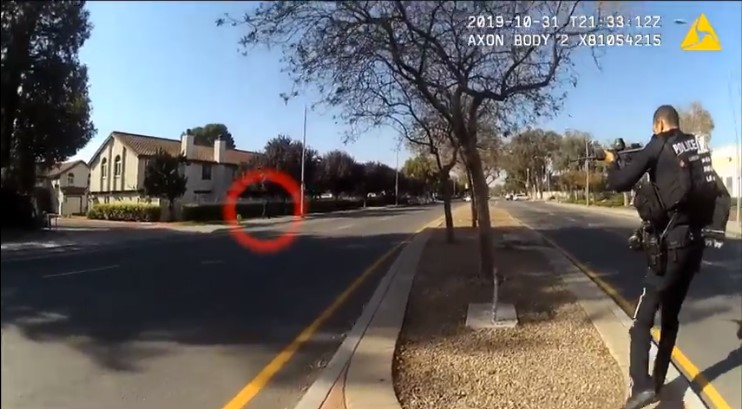SAN JOSE — A federal appellate court has revived an excessive force lawsuit over the 2019 shooting death of a man by a San Jose police officer who feared the man was heading toward a school with a gun that later turned out to be a replica firearm.
The suit filed by the mother of Francis Calonge, who was 33 when he died, was dismissed by Judge Nathanael Cousins two years ago.
Earlier this month, however, a three-judge panel from the 9th Circuit Court of Appeals disagreed and overturned the dismissal, rejecting Cousins’ reasoning that Officer Edward Carboni was covered by qualified immunity, a legal protection for government officials against being sued over their work actions absent a clear violation of constitutional or statutory rights.
The 9th Circuit panel concluded that Carboni’s shooting of Calonge, who was more than 100 feet away with his back to the officer, should be evaluated by a trial jury to determine if excessive-force damages are warranted for Rosalina Calonge.
“This case is unusual in that other officers on the scene contradict key facts asserted by the officer who used deadly force,” Judge Michelle Friedland wrote in the panel’s opinion published June 7. “We conclude that a reasonable jury could decide that Officer Carboni violated the Fourth Amendment.”
Jim McManis, the attorney for Rosalina Calonge, welcomed the appellate decision.
“We never should have had to appeal this. The law was clear, as the 9th Circuit pointed out: You can’t shoot someone in the back without a warning,” he said in an interview. “Two years later we’re back where we should have been.”
Carboni, who first joined SJPD in 2014, has the distinction of being involved in four fatal police shootings in his time with the police department. He was cleared of criminal liability by the Santa Clara County District Attorney’s Office in all four cases.
Francis Calonge was experiencing mental illness and under the influence of methamphetamine on the afternoon of Oct. 31, 2019, when he was seen in front of a gym at Jackson Avenue and McKee Road holding what a 911 caller said was a pistol. But responding officers, including Carboni, did not know that when they responded to the scene and tried to contact Calonge.
Authorities contend Calonge that walking erratically through the gym’s parking lot and that officers “gave the suspect verbal commands to stop and drop the gun,” and that Calonge defied them and instead put the weapon in his waistband.
As Calonge walked on the west side of North Jackson Avenue toward Independence High School, at 2:32 p.m. — six minutes after the initial sighting of the gun — an officer reported into his radio, “Shots fired. Shots fired … He was reaching for the gun.”
Carboni was about 120 feet southeast of Calonge, standing in the center median, when he shot Calonge once with his police-issued rifle, with the bullet hitting him in the back. Calonge died at a hospital soon after; police would determine the weapon he was carrying was a Powerline BB gun made to resemble a Beretta handgun.
A key portion of the 9th Circuit’s opinion revolves around what it called contradicting commands that Carboni and three other police officers gave to Calonge as he walked toward them from about 20 yards away. The opinion drew on deposition testimony stating that Carboni shouted “let me see your hands” and “drop it,” while another officer ordered, “don’t reach for the gun.”
Friedland would write of that conflict in her opinion: “Given that the gun was in Calonge’s waistband, it was impossible for him to both drop it and not reach for it.”
Another officer also may have ordered him to lie down on the ground, but no audio confirmation of that exchange exists.
Calonge apparently responded by turning around and walking away. Three officers followed on foot while another followed in a police vehicle. They testified that Calonge kept walking, and occasionally “looked over his shoulder a few times and smiled.”
Carboni could be heard telling the other officers, “Hey watch out, I’m going to shoot him,” and the opinion noted that “at no point had Officer Carboni warned Calonge that he was going to shoot.”
Related Articles
Victim identified in I-580 fatal Oakland crash
Sideshows in San Jose, Peninsula draw crowds and police
San Mateo: Police release more details about shooting, arrest
Fremont police shoot man after carjacking report
San Francisco homicide: Person shot in Mission District alley
Friedland also saw evidence contradicting Carboni’s stated reasons for opening fire, which were that he saw movement suggesting Calonge was drawing the gun, and that Calonge was within 15 yards of students getting out of class for the day. The judge pointed to another officer’s testimony that Calonge “did not do anything that suggested he was pulling his gun out,” and Carboni’s own body camera footage that “does not show any bystanders near Calonge or further down the sidewalk toward the intersection.”
The 9th Circuit opinion found that the facts of the shooting — when viewed in a light most favorable to the plaintiff as is required in its assessment — did not indisputably show that Calonge posed an immediate threat or that there were any bystanders at risk, or that the circumstances were so urgent that Carboni had no time to give a warning.
“Officer Carboni had time to warn his fellow officers. Then more time passed before he shot Calonge,” Friedland wrote. “A warning was therefore practicable. The fact that none was given makes the already unreasonable force even less reasonable.”
The 9th Circuit decision means that Rosalina Calonge’s lawsuit goes back to the federal district court in San Jose. It is not immediately clear when the proceedings will restart.


